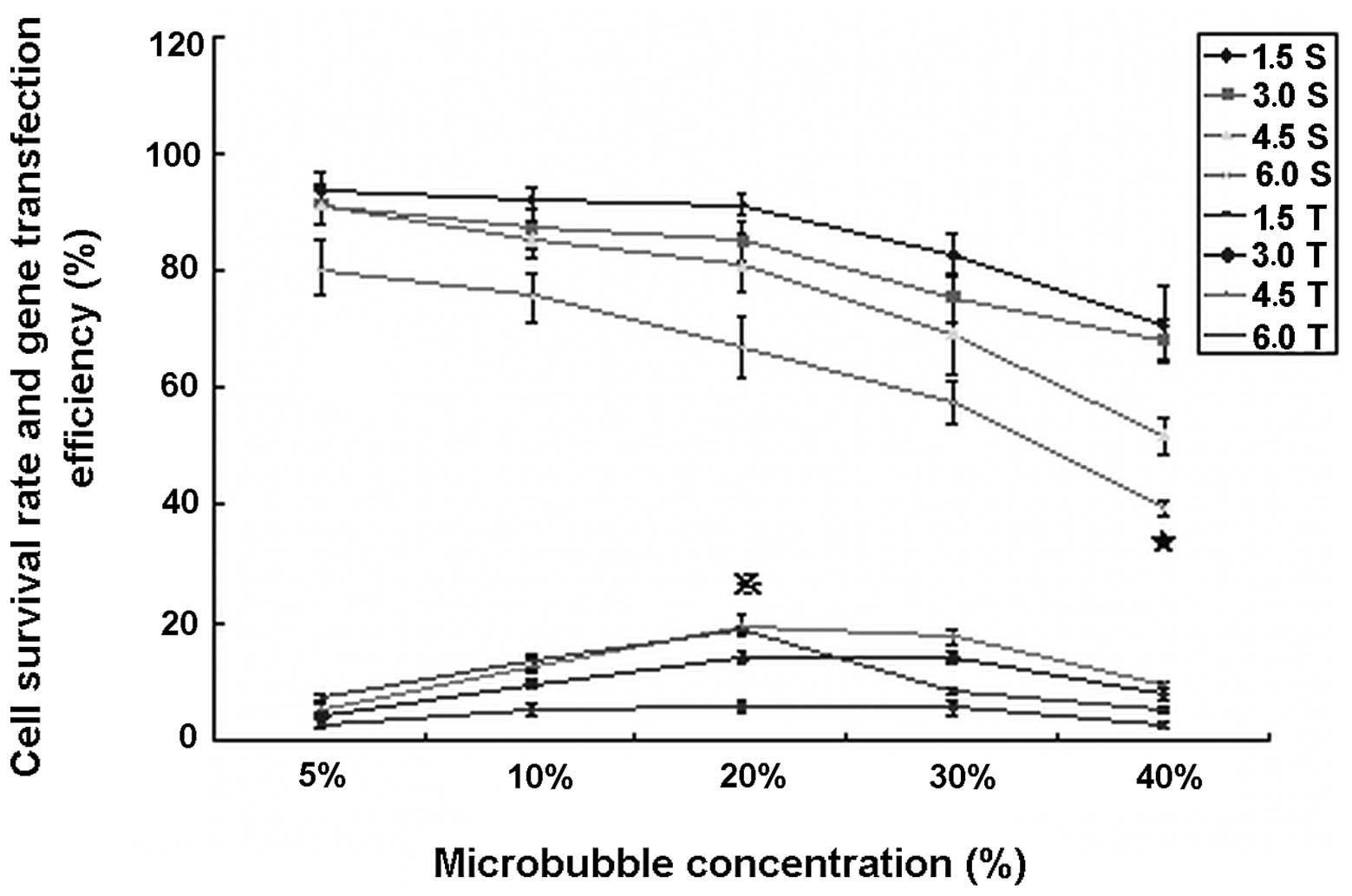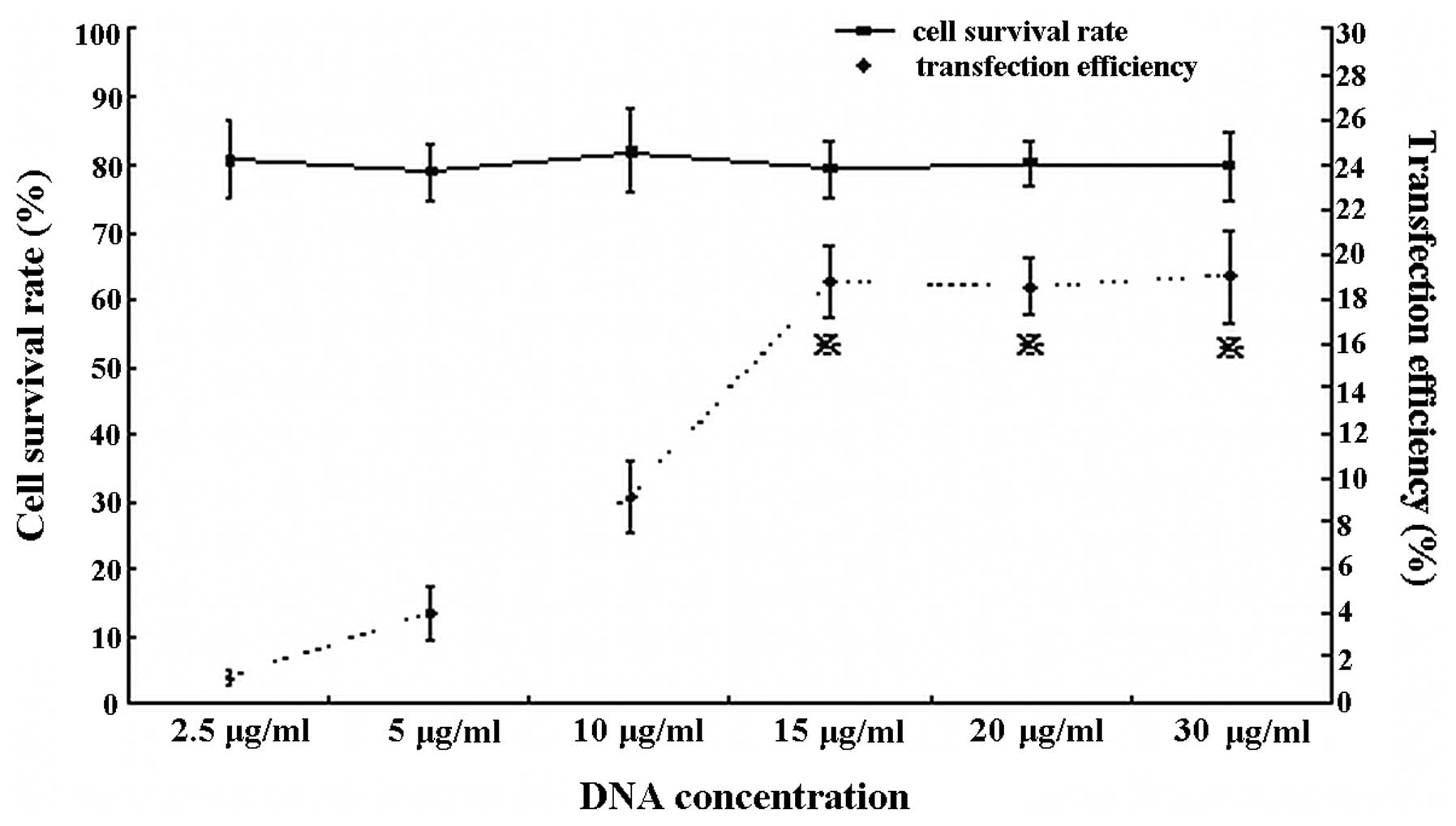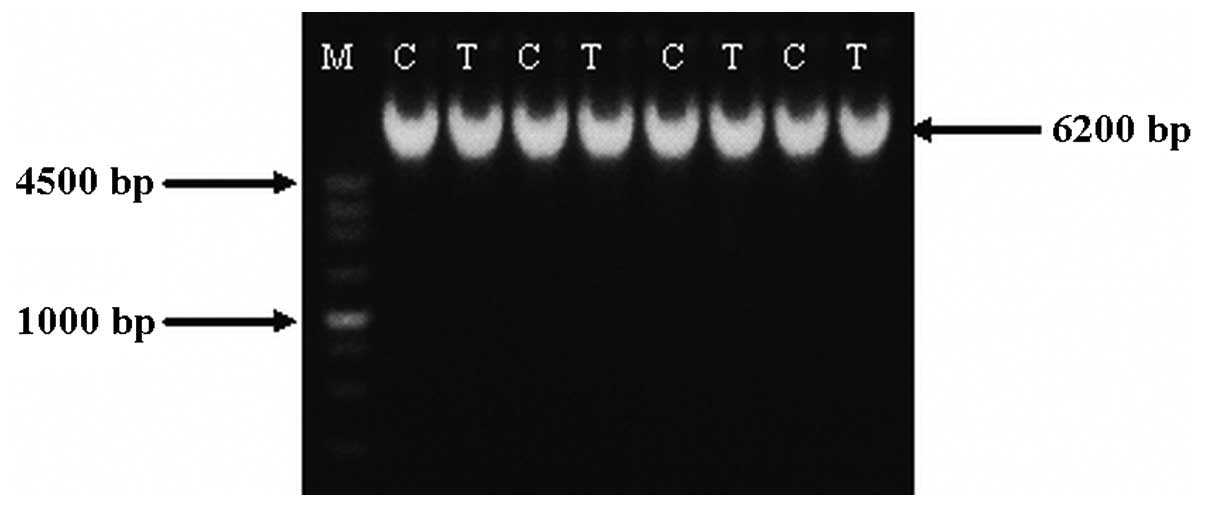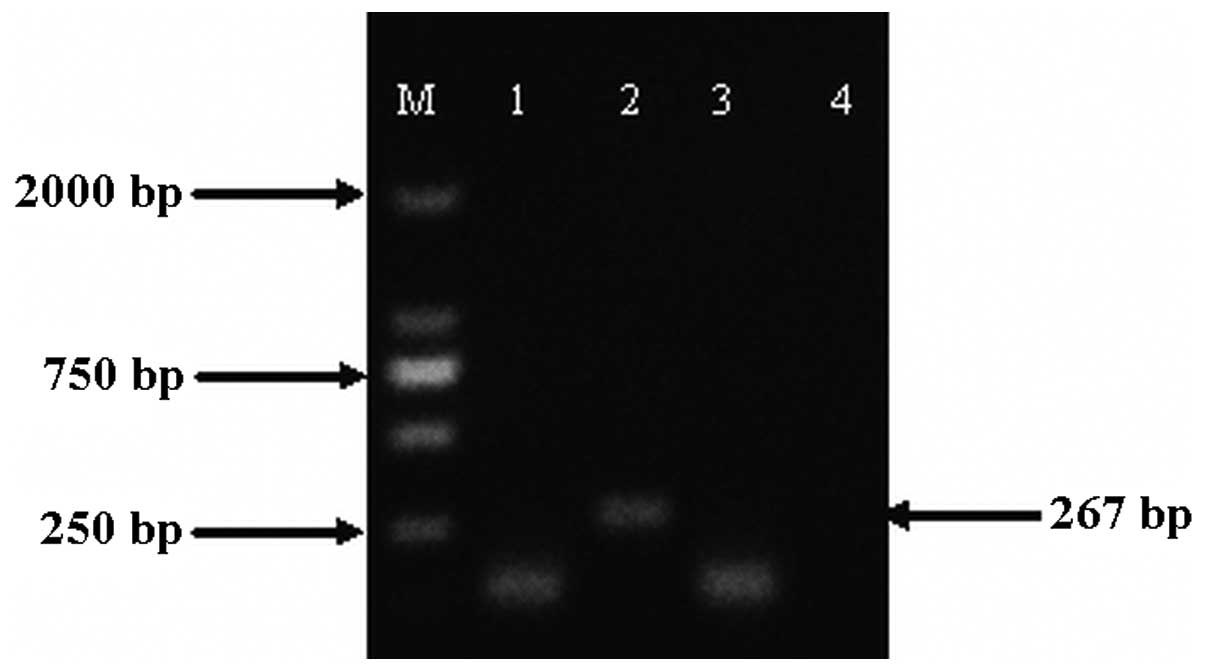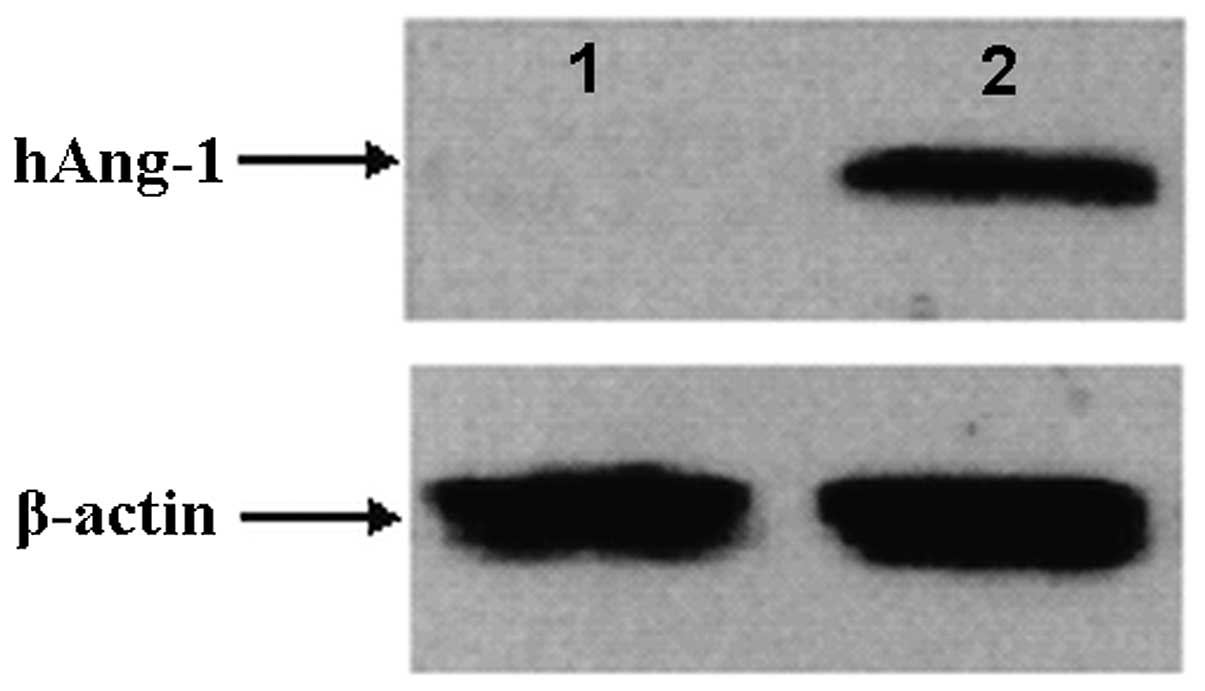Optimization of transfection parameters for ultrasound/Sonovue microbubble-mediated hAng-1 gene delivery in vitro
- Authors:
- Published online on: September 26, 2012 https://doi.org/10.3892/mmr.2012.1100
- Pages: 1460-1464
Abstract
Introduction
Ultrasound-mediated microbubble fragmentation technology is used to transport remedial exogenous genes or drugs into impaired organs or tissues and create biological effects. This technology has become an extremely promising gene delivery tool for myocardial ischemia gene therapy (1–4). Previous studies have mainly focused on the effects of ultrasound irradiation parameters on gene transfer efficiency (5–7), however, this study was designed to explore the effects of other parameters, including microbubble concentration, gene dosage, cell-microbubble mixing mode and the presence of fetal bovine serum (FBS), and how to match these parameters to achieve good gene delivery. Furthermore, therapeutic gene integrity post ultrasound irradiation was also tested, as it is fundamental for gene expression. The ultimate aim is to provide an objective basis for future angiogenesis research of microbubble/ultrasound-mediated hAng-1 gene delivery into ischemic myocardium in vivo.
Materials and methods
Preparation of SonoVue microbubble/hAng-1 gene suspension
The eGFP-hAng-1 construct was generated by PCR with a high-fidelity thermostable DNA polymerase (Fermentas Co., Glen Burnie, MD, USA) based on the pAAVAVNGPT1 plasmid (designed and presented by Wu’s Lab, College of Life Science, Wuhan University, Wuhan, China). The suspension of SonoVue microbubbles was prepared according to the manufacturer’s instructions. The SonoVue microbubble was produced by Bracco Co. (Geneva, Switzerland), with a diameter of 2.5 μm and coated with phospholipids on the surface. The mixture of the suspension of the hAng-1 plasmid and SonoVue microbubbles was kept at 4°C for 15 min with oscillation to ensure the plasmid and microbubbles were in full contact and adhered to one other. The study was approved by the ethics committee of Renmin Hospital of Wuhan University, Wuhan, China.
Determination of optimal ultrasound exposure
Human embryonic kidney 293T cells were maintained in DMEM with 10% FBS. For transfection, cells were seeded at 1×106 cells/well in 6-well plates and transfected with 10% μl/μl microbubble suspension containing 10 μg/ml hAng-1 gene via ultrasound irradiation (8–10). During transfection, the ultrasound probe was placed under the 6-well plate at a distance of 3–5 mm, and irradiation frequency was ranged from 0.5–2 MHz with continuous wave (UGT2007 ultrasound irradiation machine, Ultrasonic Research Institute, Chongqing Medical School, China). The irradiation intensity was set to 0.5, 1.0, 1.5 and 2.0 W/cm2 with exposure time set to 10, 20, 30, 60 and 120 sec. Transfected cells were exposed to ultrasound irradiation over various time courses, and transfection efficiency and cell viabilities were used to determine the optimal ultrasound exposure parameters.
Determination of optimal microbubble concentration
To determine the optimal matching parameters between microbubble concentration and ultrasound exposure, the microbubble concentration was set to 5, 10, 20, 30 and 40% (μl/μl) under the ultrasound exposure dosage of 1.5, 3.0, 4.5 and 6.0 W/cm2 × sec (intensity × time). Microbubble concentration was calculated as microbubble solution volume/(microbubble solution volume + reaction system volume; μl/μl). The plasmid DNA concentration was 10 μg/ml. hAng-1 gene delivery rate and cell death under these conditions were used to determine the optimal microbubble concentration.
Determination of optimal plasmid DNA concentration
To determine the optimal concentration of the hAng-1 gene in cell suspension, plasmids were prepared at 2.5, 5, 10, 15, 20 and 30 μg/ml. hAng-1 gene delivery rate and cell death under optimal microbubble conditions and ultrasound radiation parameters remained as above.
Determination of mixed mode of cells and microbubble
To determine the effect of mixed mode on transfection efficiency and cell viabilities, 293T cells and microbubbles carrying the hAng-1 gene were cultured in adherence and suspension modes. In suspension mode, the microbubbles carrying the gene were added into cultured 293T cells in 6-well plates at the moment of inoculation, followed by ultrasound irradiation. Under adherence mode, 293T cells at 1×106/ml concentration were seeded in 6-well plates (total number of cells remained constant under both modes). Following adhesion, the microbubble suspension carrying the gene was added, followed by ultrasound irradiation. All other experimental parameters remained constant between the two modes.
Effect of FBS on transfection system
To determine the effect of FBS on transfection efficiency and cell viability, the transfection efficiency of 293T cells, transfected with the hAng-1 plasmid at 15 μg/ml concentration via ultrasound irradiation with 8% FBS was compared with that in the absence of FBS. All other experimental parameters followed the above optimal conditions and remained constant between the two groups.
Control group
Cells were transfected with microbubble suspension carrying the gene hAng-1 as the experimental group, and cells were transfected with only the hAng-1 gene as the control group. All other experimental parameters remained constant.
Determination of gene transfection efficiency and cell viability
Fluorescence quantity and intensity of green fluorescent protein (GFP) under the fluorescence microscope and percentage of eGFP positive cells via flow cytometry were used to determine the transfection efficiency. Cell viability was determined by 0.4% trypan blue staining and the cell counting method. Cell morphology and structure were compared using an inverted microscope under the conditions stated.
Detection of hAng-1 mRNA
hAng-1 gene expression at the mRNA level was determined by quantitative RT-PCR. The primer sequence used for detection was designed, upstream, 5′-TGCCATTACCAGTCAGAGG-3′, and downstream, 5′-CAAGCATCAAACCACCATC-3′, using Primer Premier 5.0 software and the product was analyzed by 1% agarose gel electrophoresis.
Detection of hAng-1 protein
hAng-1 gene expression at the protein level was determined by western blot analysis. Cell lysis was performed 48 h following hAng-1 gene transfection and hAng-1 protein was detected using a primary antibody against hAng-1, purchased from Abcam Co. (Cambridge, MA, USA; Angiopoietin 1 antibody, ab8451).
Analysis of DNA integrity following microbubble-mediated gene transfer
To determine the integrity of DNA after ultrasound irradiation, the hAng-1 solution was analyzed by agarose gel electrophoresis following ultrasound irradiation. The result was compared with that of the hAng-1 gene solution wtihout ultrasonic irradiation.
Statistical analysis
SPSS 11.0 was used for statistical analysis. Data are expressed as the mean ± SD, and one-way ANOVA and post hoc tests were used to analyze the significance of hAng-1 gene transfection efficiency and cell viability under the above various experimental conditions.
Results
Ultrasound exposure parameters
Gene transfection efficiency increased with enhancement of irradiation intensity and extension of irradiation time. However, further increases were not obtained at irradiation intensity and duration beyond 1.5 W/cm2 and 30 sec. In addition, cell viability decreased significantly beyond these settings (Tables I and II). Taking into account the transfection efficiency and cell survival rate, 1.5 W/cm2 and 30 sec were set as optimal conditions in our experiments.
Table IEffect of ultrasonic irradiation intensity on efficiency of gene transfer and cell viability (mean ± SD). |
Table IIEffect of ultrasonic irradiation duration on efficiency of gene transfer and cell viability (mean ± SD). |
Microbubble concentration
Gene delivery efficiency was relatively low at a microbubble concentration of 5 and 10% (μl/μl), efficiency increased significantly at 20 and 30% concentrations under 3.0 W/cm2 × sec, reaching the highest level at 4.5 W/cm2 × sec. No significant differences were identified with respect to gene delivery efficiency between these two microbubble concentrations under the ultrasound irradiation of 3.0 W/cm2 × sec (14.04±1.04 vs.13.92±0.97%, P>0.05) and 4.5 W/cm2 × sec (19.66±1.67 vs. 17.54±1.41%, P>0.05). However, the gene transfection efficiency was significantly decreased at 40% microbubble concentration under any ultrasound exposure condition (P<0.01). Cell viability was significantly decreased at microbubble concentrations >30% (P<0.01; Fig. 1). Therefore, 20% microbubble concentration was determined as optimal for experiments.
DNA concentration
Gene transfection efficiency was low at DNA concentrations of 2.5 μg/ml (1.08±0.35%) and 5 μg/ml (3.98±1.13%); it increased significantly at DNA concentrations of 10 μg/ml (9.14±1.56%) under ultrasound irradiation of 1.5 W/cm2 and 30 sec (ultrasound exposure dose, 4.5 W/cm2 × sec) with 20% microbubble concentration. Thereafter, the efficiency reached a plateau level at DNA concentrations of 15, 20 and 30 μg/ml. No significant differences were identified among the above concentrations (18.74±1.57, 18.52±1.29 and 19.02±2.10, respectively, all P>0.05). No significant differences were identified in cell viability between the various DNA concentrations (Fig. 2). In our experiments, 15 μg/ml was determined to be the optimal plasmid concentration.
FBS
No significant differences were identified in gene transfection efficiency between the group containing 8% FBS and the group in its absence (19.2±1.1 vs. 19.7±0.9%, P>0.05). In addition, no significant differences in cell viability were identified between the two groups (86.3±2.1 vs. 86.6±1.7%, P>0.05; results not shown).
Mixing mode of cell and microbubble
The gene transfection efficiency was 8–15% under the cell adherence mode (10.4±1.2%); however, the cell survival rate was significantly decreased following ultrasound irradiation (65.4±2.9%). Comparatively, gene delivery efficiency reached almost 20% (19.7±0.7%, P<0.01) under cell suspension mode without a significant decrease in cell viability (76.6±2.1%, P<0.01). Therefore, the cell suspension mode was the optimal mode in our experiments.
Integrity of hAng-1 DNA
Agarose gel electrophoresis revealed a band corresponding to the hAng-1 gene that underwent ultrasound irradiation at the same position as a band produced for the hAng-1 plasmid which had not undergone ultrasound irradiation. This indicates that ultrasound irradiation used in this experiment did not cause the hAng-1 gene DNA chain to break, and therefore did not affect integrity (Fig. 3).
Determination of mRNA of hAng-1 gene
Following 48-h transfection, there was marked eGFP-C3-hAng-1 mRNA expression in the ultrasound/microbubble-mediated gene delivery group compared with the control group, demonstrating that the eGFP-C3-hAng-1 gene is expressed via the ultrasound/microbubble-mediated method (Fig. 4).
Determination of hAng-1 protein
hAng-1 protein was detected using SDS-PAGE/western blot analysis in the ultrasound/microbubble-mediated gene delivery group but was absent in the control group. This implied that the delivery process via ultrasound/microbubbles does not affect the gene eGFP-C3-hAng-1a translation into the functional protein (Fig. 5).
Discussion
Optimal gene transfection conditions are utilized to enhance gene expression levels and restrict cell death to 5% or less (11). Previous studies have discussed the effect of ultrasound exposure and irradiation intensity on gene delivery (12,13); however, the influential factors are more extensive than discussed. Contrast agents, target cell and tissue type, corpuscular physiological status and uptake capacity of cells to DNA, etc., are the most common factors affecting the efficiency of gene transfer (14). Determining how to match these parameters to achieve optimal conditions is critical for the improvement of gene delivery and expression.
The present study aimed to investigate hAng-1 gene delivery efficiency and cellular viability under various conditions. The study mainly focused on contrast agent, DNA concentration, mixing mode of microbubble and cells and the presence of FBS. With regard to contrast agent, we identified that when the SonoVue microbubble was used as a gene transport medium, with a gradual increase in ultrasound irradiation intensity to 1.5 W/cm2 and exposure time to 30 sec, and a microbubble concentration of 20%, a progressive increase in hAng-1 gene transfer was observed. Cell viability was gradually decreased, although it remained at an acceptable range. The above three parameters had similar effects on gene delivery and cell viability. However, hAng-1 gene delivery did not continue to rise with continued increase of levels of the above parameters. This indicates that for a certain type of cell or tissue, particular gene transfection efficiency cannot be increased after reaching saturated levels. Beyond this level, the gene transfection efficiency decreased rather than increased, likely due to extensive cell death. Under these conditions, the ultrasound/microbubble gene delivery may become unsafe. It should be noted that under conditions of transfection saturation, a small increase in ultrasound exposure or the microbubble concentration improves gene transfection minimally, and at the cost of a large number of cell deaths. Therefore, to obtain the optimal transfection parameters, instead of maximal transfection efficiency, we should select lower levels of ultrasound radiation intensity, exposure duration and microbubble concentration within the plateau phase parameters to achieve higher transfection efficiency and ensure the safety of ultrasound/microbubble as a gene carrier.
In addition, we revealed that the mixed mode of microbubbles and cells also affected transfection efficiency. In preliminary experiments, we observed that in order to obtain high transfection efficiency, cell and microbubble contact must be sufficient. Thus, we added the microbubble solution with a concentration of 20% microbubble solution per μl into the adherent cells in a 6-well plate after removing the culture medium, and then performed ultrasound irradiation. Although this method improved the transfection efficiency, it reduced cell viability notably and generated unstable results and poor reproducibility. The causes may be: i) the microbubble always floats on the surface of the transfection system due to buoyancy effects, thus it cannot be in contact with adherent cells, ultimately decreasing the effects of the microbubble on cells; ii) ultrasonic irradiation causes detachment of adherent cells from the bottom of the 6-well plate, resulting in reduced cell activity. Therefore, we mixed the concentrated cell suspension with the microbubble solution. We identified that this method not only increased contact opportunity between microbubbles and cells, but also reduced the negative effects on cell activity, thereby, significantly increasing Ang-1 gene transfection and decreasing cell injury.
Previous studies used fresh culture medium without serum during gene transfection, changing to culture medium containing serum post-transfection during the in vitro ultrasound/microbubble gene delivery experiment (15–17). The ultimate aim of the present study was to apply this new gene delivery system in vivo, therefore it was necessary to investigate the system in the presence of FBS, to determine whether the microbubble/ultrasound-mediated gene transfer system performed an effective gene transfection. The results of this study indicate that the presence of FBS has no effects on the hAng-1 gene transfection efficiency and cell viability. The therapeutic gene was previously reported to be administered by intravenous injection, therefore, successful transfection of the plasmid DNA in vitro in the presence of FBS may be of greater value for application of the ultrasound-directed gene transfer to cardiovascular disease therapy in vivo.
Successful gene transfection not only requires cells to take up the exogenous gene, but also maintain normal function of expression and translation of the ingested gene. The heat and micro-jet generated by cavitation effects may cause the plasmid DNA to fragment (18,19), endanger the integrity of DNA and affect its normal expression and functions. Therefore, we investigated DNA integrity under optimal transfection conditions. We identified that under optimal conditions, the ultrasound/microbubble-mediated gene transfection system did not affect DNA integrity in vitro. Furthermore, detection of hAng-1 mRNA by quantitative RT-PCR and hAng-1 protein by SDS-PAGE/western blot analysis provided evidence that the transferred hAng-1 gene was expressed, and suggested normal function inside the cells.
Current studies demonstrate relatively low transfection efficiency, which is a common challenge for all non-viral gene delivery methods (20,21). The main causes may be correlated with lack of effective protection of the plasmid when entering the cytoplasm and possible degradation of the plasmid by DNase in the cytoplasm before entering the nucleus (22). It is vital to successfully optimize transfection parameters of the hAng-1 gene as an angiogenesis gene for cardiac ischemic diseases therapy in humans, including thorough understanding of the effects of the system on blood flow and ultrasound energy attenuation following penetration of skin and muscle tissue (23). The above optimal parameters function as a significant reference, but currently remain unsuitable for experiments in vivo.
To summarize, for a particular type of contrast agent, the exogenous gene, and the target tissue or cell, it is necessary to determine the specific optimal transfection conditions for utilization of the ultrasound/microbubble gene transfer system. Gene transfection efficiency is determined by multiple factors and interactions. Further studies are required to clarify the biological effects and functional mechanisms.
Acknowledgements
This study was supported by a grant from the National Natural Science Fundation of China (30600141).
References
|
Korpanty G, Chen S, Shohet RV, et al: Targeting of VEGF-mediated angiogenesis to rat myocardium using ultrasonic destruction of microbubbles. Gene Ther. 12:1305–1312. 2005. View Article : Google Scholar : PubMed/NCBI | |
|
Inagaki H, Suzuki J, Ogawa M, Taniyama Y, Morishita R and Isobe M: Ultrasound-microbubble-mediated NF-kappaB decoy transfection attenuates neointimal formation after arterial injury in mice. J Vasc Res. 43:12–18. 2006. View Article : Google Scholar : PubMed/NCBI | |
|
Yamashita T, Sonoda S, Suzuki R, et al: A novel bubble liposome and ultrasound-mediated gene transfer to ocular surface: RC-1 cells in vitro and conjunctiva in vivo. Exp Eye Res. 85:741–748. 2007. View Article : Google Scholar : PubMed/NCBI | |
|
Shen ZP, Brayman AA, Chen L and Miao CH: Ultrasound with microbubbles enhances gene expression of plasmid DNA in the liver via intraportal delivery. Gene Ther. 15:1147–1155. 2008. View Article : Google Scholar : PubMed/NCBI | |
|
Larina IV, Evers BM and Esenaliev RO: Optimal drug and gene delivery in cancer cells by ultrasound-induced cavitation. Anticancer Res. 25:149–156. 2005.PubMed/NCBI | |
|
Duvshani-Eshet M, Adam D and Machluf M: The effects of albumin-coated microbubbles in DNA delivery mediated by therapeutic ultrasound. J Control Release. 112:156–166. 2006. View Article : Google Scholar : PubMed/NCBI | |
|
Nie F, Xu HX, Tang Q and Lu MD: Microbubble-enhanced ultrasound exposure improves gene transfer in vascular endothelial cells. World J Gastroenterol. 12:7508–7513. 2006.PubMed/NCBI | |
|
Taniyama Y, Tachibana K, Hiraoka K, et al: Development of safe and efficient novel nonviral gene transfer using ultrasound: enhancement of transfection efficiency of naked plasmid DNA in skeletal muscle. Gene Ther. 9:372–380. 2002. View Article : Google Scholar : PubMed/NCBI | |
|
Guo DP, Li XY, Sun P, et al: Ultrasound/microbubble enhances foreign gene expression in ECV304 cells and murine myocardium. Acta Biochim Biophys Sin. 36:824–831. 2004. View Article : Google Scholar : PubMed/NCBI | |
|
Li T, Tachibana K and Kuroki M and Kuroki M: Gene transfer with echo-enhanced contrast agents: comparison between Albunex Optison and Levovist in mice - initial results. Radiology. 229:423–428. 2003. View Article : Google Scholar : PubMed/NCBI | |
|
Miller DL, Dou C and Song J: DNA transfer and cell killing in epidermoid cells by diagnostic ultrasound activation of contrast agent gas bodies in vitro. Ultrasound Med Biol. 29:601–607. 2003. View Article : Google Scholar : PubMed/NCBI | |
|
Li YS, Davidson E, Reid CN and McHale AP: Optimising ultrasound-mediated gene transfer (sonoporation) in vitro and prolonged expression of a transgene in vivo: potential applications for gene therapy of cancer. Cancer Lett. 273:62–69. 2009. View Article : Google Scholar : PubMed/NCBI | |
|
Kinoshita M and Hynynen K: Key factors that affect sonoporation efficiency in in vitro settings: the importance of standing wave in sonoporation. Biochem Biophys Res Commun. 359:860–865. 2007. View Article : Google Scholar : PubMed/NCBI | |
|
Suzuki R, Takizawa T, Negishi Y, Utoguchi N and Maruyama K: Effective gene delivery with novel liposomal bubbles and ultrasonic destruction technology. Int J Pharm. 354:49–55. 2008. View Article : Google Scholar : PubMed/NCBI | |
|
Rahim A, Taylor SL, Bush NL, ter Haar GR, Bamber JC and Porter CD: Physical parameters affecting ultrasound/microbubble-mediated gene delivery efficiency in vitro. Ultrasound Med Biol. 32:1269–1279. 2006. View Article : Google Scholar : PubMed/NCBI | |
|
Taniyama Y, Tachibana K, Hiraoka K, et al: Development of safe and efficient novel nonviral gene transfer using ultrasound: enhancement of transfection efficiency of naked plasmid DNA in skeletal muscle. Circulation. 105:1233–1239. 2002.PubMed/NCBI | |
|
Guo DP, Li XY, Sun P, et al: Ultrasound-targeted microbubble destruction improves the low density lipoprotein receptor gene expression in HepG2 cells. Biochem Biophys Res Commun. 343:470–474. 2006. View Article : Google Scholar : PubMed/NCBI | |
|
O’Brien WD Jr: Ultrasound-biophysics mechanisms. Prog Biophys Mol Biol. 93:212–255. 2007. | |
|
Kimmel E: Cavitation bioeffects. Crit Rev Biomed Eng. 34:105–161. 2006. View Article : Google Scholar | |
|
Glover DJ, Lipps HJ and Jans DA: Towards safe non-viral therapeutic gene expression in humans. Nat Rev Genet. 6:299–310. 2005. View Article : Google Scholar : PubMed/NCBI | |
|
Hurtado Picó A, Wang X, Sipo I, et al: Viral and nonviral factors causing nonspecific replication of tumor- and tissue-specific promoter-dependent oncolytic adenoviruses. Mol Ther. 11:245–256. 2005. | |
|
Mehier-Humbert S, Bettinger T, Yan F and Guy RH: Ultrasound-mediated gene delivery: Kinetics of plasmid internalization and gene expression. J Control Release. 104:203–211. 2005. View Article : Google Scholar : PubMed/NCBI | |
|
Suzuki R, Takizawa T, Negishi Y, et al: Tumor specific ultrasound enhanced gene transfer in vivo with novel liposomal bubbles. J Control Release. 125:137–144. 2008. View Article : Google Scholar : PubMed/NCBI |



